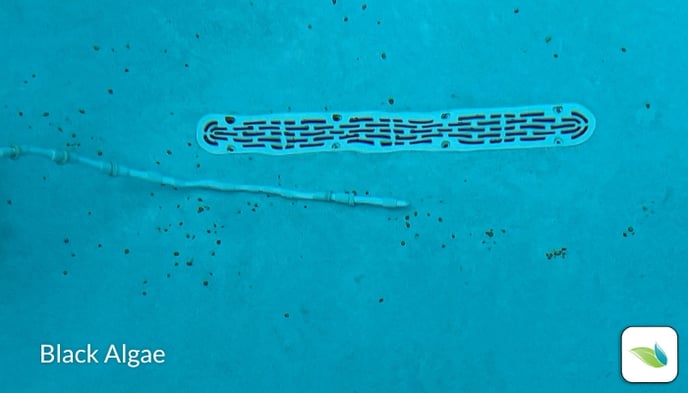What is black algae (cyanobacteria)?
Black algae (cyanobacteria) look like small black spots in a swimming pool, and they are protected by a chlorine-resistant polysaccharide layer.
Black algae are not technically algae; they are cyanobacteria. That being said, they are somewhat of a hybrid between bacteria and plants because cyanobacteria have chloroplasts. This means they harvest light as a nutrient, just like a plant would.

These bacteria grow in a way that appears like small black spots stuck to pool surfaces. Over time, they multiply and spread around the pool surface. This can happen because black algae colonies are sanitizer-resistant due to a protective film (or shield). More on this in a moment.
Black algae's protective layer
While there are many species of cyanobacteria, the types that are found in pools share many similarities. From what we have learned, black algae are protected by a peptidoglycan layer. This layer is primarily made up of covalently-linked polysaccharides and proteins.
There is also an outer membrane (biofilm) that is highly chlorine-resistant. This biofilm is primarily composed of proteins, lipids, and carotenoids. Read this study (Woitzik, Weckesser and Jürgens, 1988) to learn more.
In the pool industry, this protective layer is referred to as the black algae "shield", or "shell", or "head", or "helmet", or "cap". They all mean the same thing. Whatever you want to call it, this protective layer is a tough material that is difficult to remove, even with brushing.
How do black algae get in a swimming pool in the first place?
Unlike green and yellow algae, which can spawn from billions of spores everywhere in nature (leaves, grass, soils, you name it), black algae need to be introduced to the pool.
- The number one cause of contamination is a pool brush that was previously used on a pool with black algae.
If you are a pool pro dealing with black algae, the brush you use on a contaminated pool should be devoted only to contaminated pools. Get a separate brush for all the other pools. And after each treatment, disinfect the brush and physically clean it with hot water or a pressure washer to remove any material from within the bristles. - The number two cause of black algae is cross-contamination from swimsuits and toys that have been used in lakes, ponds, rivers, and other natural water.
If people were tubing the river or playing in the lake, their swimsuits need to be washed before they get in the pool. The same goes for pool toys, which should be thoroughly disinfected with a chlorine-based disinfectant product (NOT ammonia-based disinfectants).
Black algae can be prevented by regular pool maintenance, optimizing chlorination (like avoiding overstabilization), and avoiding contamination from brushes and swimsuits that could introduce black algae into the pool in the first place.